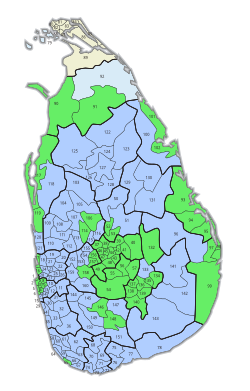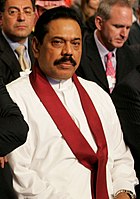Sri Lankan presidential election, 2005
|
|
||||||||||||||||||||||||||
|---|---|---|---|---|---|---|---|---|---|---|---|---|---|---|---|---|---|---|---|---|---|---|---|---|---|---|
|
||||||||||||||||||||||||||
| Turnout | 73.73% | |||||||||||||||||||||||||
|
||||||||||||||||||||||||||

polling divisions won by
■ – Mahinda Rajapaksa ■ – Ranil Wickremesinghe |
||||||||||||||||||||||||||
|
||||||||||||||||||||||||||
■ – Mahinda Rajapaksa ■ – Ranil Wickremesinghe
■ – Mahinda Rajapaksa (turnout below 2%)
Chandrika Kumaratunga
United People's Freedom Alliance
Mahinda Rajapaksa
United People's Freedom Alliance
The Sri Lankan presidential election of 2005 was the fifth presidential election of Sri Lanka. Nominations were accepted on 7 September 2005, and the election was held on 17 November 2005. Electoral participation was 73.73%. Prime Minister Mahinda Rajapaksa of the governing United People's Freedom Alliance was elected, receiving 50.3% of all votes cast.
At first, there was doubt whether the election would be held at all. President Chandrika Kumaratunga had called the 1999 election one year ahead of schedule; she argued that the extra year should be appended to her second term, and filed suit do to this. The Supreme Court of Sri Lanka rejected her claims and the election went ahead.
Prime Minister Mahinda Rajapaksa quickly emerged as the candidate for the Sri Lanka Freedom Party and Ranil Wickramasinghe for the United National Party. Both candidates tried to round up the support of minor parties. Rajapaksa needed to re-assemble the alliance with the Janatha Vimukthi Peramuna that existed at the parliamentary level (the United People's Freedom Alliance). After he agreed to reject federalism and renegotiate the ceasefire with the Liberation Tigers of Tamil Eelam, the JVP and the Jathika Hela Urumaya endorsed him.
...
Wikipedia


